Types and examples of Protists
Biologists consider protists as a polyphyletic group, which means they probably do not share a common ancestor. The word protists comes from the Greek word for first, indicating that researchers believe protists may have been the first eukaryotes to evolve on Earth. Now, the Protists are classified in to three main types or subdivisions on the basis of their similarity with other kingdoms. These are
- Protozoa (animal like protists)
- Molds (Fungus Like Protists)
- Algae ( Plants like Protists)
A) Protozoa (animal like protists)
Protozoa are single-celled organisms. These are also called animal like protists. All protozoa are heterotrophic, that is, they feed on other organisms to obtain nutrition. There are also parasitic protozoa that live in the cells of larger organisms.
Protozoa can be divided into four main groups:
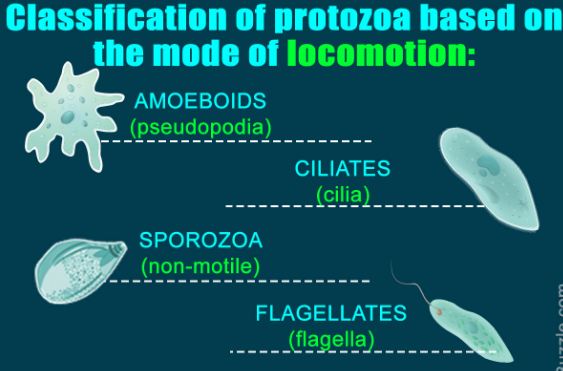
- Phylum Sporozoa (Parasitic Protozoans): e.g. malaria
- Phylum Ciliophora (Ciliated Protozoans): e.g. paramecia
- Phylum Rhizopoda (Amoeboid Protozoans): e.g. amoeba
- Phylum Zoomastigophora (Flagellate Protozoans): e.g. Trypanosoma
1- Phylum Rhizopoda (Amoeboid Protozoans): e.g. amoeba

- These are a group of protozoa characterized by their amoeboid movement through temporal projections called pseudopodia.
- They are found mainly in bodies of water, either fresh or saline.
- They have pseudopodia (false feet) that help change their shape and capture and wrap food. e.g. Ameba “Amoeboid cells may also produce in fungi, algae, and animals”
2- Phylum Zoomastigophora (Flagellate Protozoans): e.g. Trypanosoma
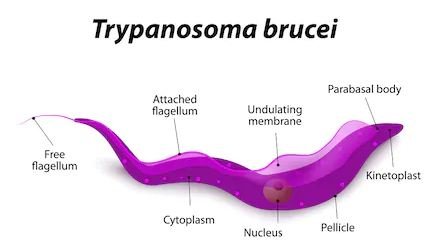
- As the name suggests, These protozoans have one or more flagella for locomotion and sensation. A flagellum is a structure resembling hair capable of lashing movements similar to lashes that provide locomotion.
- They can be free-living (Euglena) as well as parasites (Trypanosoma).
- Parasitic forms live in the intestine or bloodstream of the host.
- They may also be colonial (volvox), Solitary (Phaeocystis)
3- Phylum Ciliophora (Ciliated Protozoans): e.g. paramecia

- The ciliates are a group of protozoa characterized by the presence of hair-like organelles called cilia, whose structure is identical to that of eukaryotic flagella, but which are generally shorter and present in much greater numbers, with a wavy pattern.
- The cilia help in locomotion and obtaining nutrition.
- These are single-celled organisms and are always aquatic.
- Paramecium is a model ciliate living in freely in freshwater. The most widely distributed species are Paramecium caudatum and Paramecium aurelia.
4- Phylum Sporozoa (Parasitic Protozoans) e.g. the malaria parasite, Plasmodium
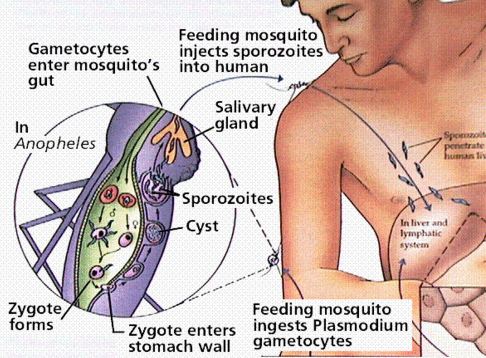
- These organisms are named so because of the presence of spores in their life cycle.
- Sporozoa have neither flagella, eyelashes, nor pseudopodia. They are able to slip movements.
- All Sporozoa are parasites of animals and cause disease.
B) Molds (Fungus Like Protists)
Molds are saprophytic organisms (they feed on the dead and decomposing matter). These are small organisms that have many nuclei. Molds are usually characterized by the presence of spores and are even visible to the naked eye. Basically they are divided into two types, viz. Water molds and Slime molds.
Oomycota or oomycetes (generally called water molds)
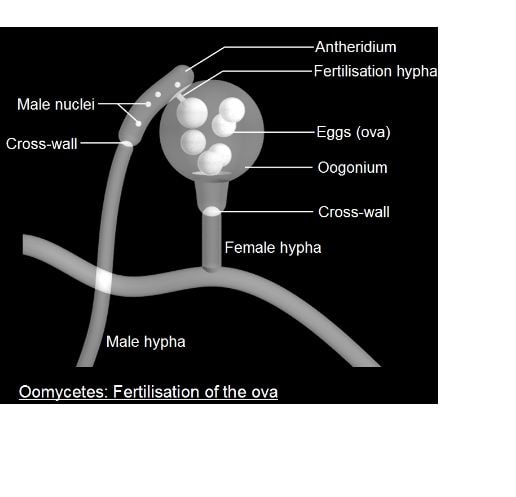
- These are a group of filamentous protists that physically resemble fungi and are heterotrophic.
- They are microscopic, absorptive organisms that reproduce both sexually and asexually and are made of a tube-like vegetative body called mycelia.
- These may be free-living or parasitic. The parasitic form may grow on the scales or eggs of fish, or on amphibians or plant bodies.
- A notorious example of water molds is Phytophthora infestans, a microorganism that causes the serious potato and tomato disease known as late blight or potato blight.
Myxomycota or myxomycetes ( generally called as Slime mold)
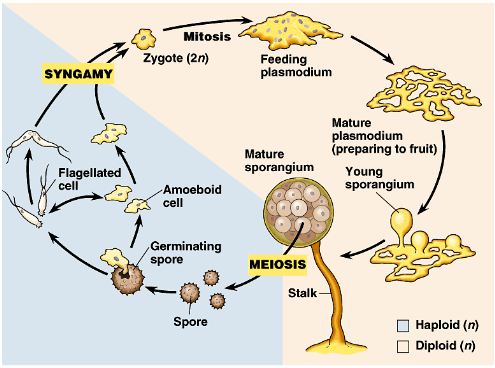
- Slime molds are several kinds of unrelated eukaryotic organisms that can live freely as single cells but can aggregate together to form multicellular reproductive structures.
- These grow as a naked network of protoplasm that engulf bacteria and other small food particles by phagocytosis.
- Slime molds are common in moist, organic-rich environments such as damp, rotten wood, where there is an abundance of bacteria as a food source. They are mostly seen as they begin to sporulate because of their conspicuous and brightly colored fruiting bodies.
- They may be
- Plasmodial slime molds such as Physarum species
- Cellular slime molds which are unicellular amoeboid organisms such as Dictyostelium
- Endoparasitic slime molds such as the Plasmodiophora brassicae that causes clubroot disease of cruciferous crops.
C) Algae ( Plants like Protists)
These form another category under the Protista kingdom. These are generally unicellular or multicellular organisms. These are photosynthetic, they are found mainly in freshwater sources or marine lakes. They are characterized by a rigid cell wall.

There are seven main types of algae that are following.
- Green algae (Chlorophyta)
- Euglenophyta (Euglenoids)
- Golden-brown algae and Diatoms (Chrysophyta)
- Fire algae (Pyrrophyta)
- Red algae (Rhodophyta)
- Yellow-green algae (Xanthophyta)
- Brown algae (Phaeophyta)
Green algae (Chlorophyta)
Examples: Chlorella, Chlamydomonas, Spirogyra, Ulva. Green algae.
- The green color pigments i.e. chlorophyll a and b are present in the Chlorophyta.
- Food reserves of Chlorophyta are starch, some fats or oils like higher plants.
- Green algae are believed to have the parents of higher green plants.
- Green algae can be unicellular (having one cell), multicellular (having many cells), colonial (many single cells living as an aggregation), or coenocytic (composed of a large cell with no crossed walls; the cell can be uninucleated or multinucleated).
Euglenophyta (Euglenoids)
Examples: Euglena mutabilis or Colacium Sp.
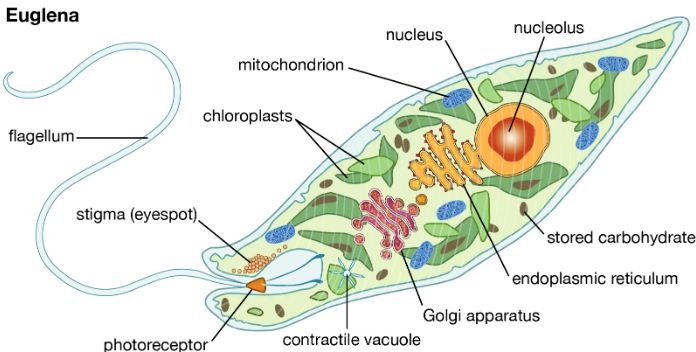
- Euglenoids are single-celled protists that occur in freshwater habitats and wet soils.
- These actively swim in an aquatic environment with the help of their long flagellum. They can also perform creeping movements by expanding and contracting their body. This phenomenon is called the euglenoid movement.
- They have two flagella at the anterior end of the body.
- There is a small light-sensitive eyespot in their cell.
- They contain photosynthetic pigments like chlorophyll and therefore can prepare their own food. However, in the absence of light, they behave similarly to heterotrophs when capturing other small aquatic organisms.
- They have characteristics similar to those of plants and animals, which makes them difficult to classify and, therefore, are called connecting links between plants and animals.
Golden-brown algae and Diatoms (Chrysophyta)
Examples: Ochromonas sp., Chrysosaccus sp.
- Chrysophyta includes single-celled algae in which chloroplasts contain large amounts of fucoxanthin pigment, giving the algae their brown color.
- These are flagellated, with one tinsel-like flagellum and a second whiplash-like flagellum, which can be reduced to a short stub.
- Resting cysts or spores with ornamented spines are formed in Chrysophyta. The cyst walls contain silica.
- Chrysophytes are found mainly in low-calcium freshwater habitats.
Fire algae (Pyrrophyta)
Examples: Pfiesteria piscicida, Gonyaulax catenella, Noctiluca scintillans, Chilomonas sp., Goniomonas sp
- Fire algae are single-celled algae commonly found in the oceans and some freshwater sources that use flagella to move.
- They are divided into two classes: dinoflagellates and cryptomonads.
- Dinoflagellates can cause a phenomenon known as red tide, in which the ocean appears red due to its high abundance. Like some fungi, some Pyrrophyta species are bioluminescent. At night, they make the ocean seem a flame. Dinoflagellates are also toxic because they produce a neurotoxin that can alter the proper functioning of muscles in humans and other organisms.
- Cryptomonads are similar to dinoflagellates and can also produce harmful algal blooms, giving the water a red or dark brown appearance.
Red algae (Rhodophyta)
Example; Gelidium, Gracilaria, Porphyra, Palmaria, Euchema
- Red algae are commonly found in tropical marine areas.
- Unlike other algae, these eukaryotic cells lack flagella and centrioles.
- It grows on a solid surface, including a tropical reef or attached to other algae.
- The cell wall of Red algae is made up of cellulose and many different types of carbohydrates.
- These algae reproduce asexually by monospores (walled spherical cells without flagella) that are carried by streams until germination.
- Red algae also reproduce sexually and undergo alternation of generations.
Yellow-green algae (Xanthophyta)
Examples: Vaucheria, Botrydium, Heterococcus,
- They are single-celled organisms with cellulose and silica cell walls and contain one or two flagella for movement.
- Its chloroplasts do not have a certain pigment, which gives them a lighter color.
- Yellow-green algae generally live in freshwater but can be found in saltwater and wet soils.
Brown algae (Phaeophyta)
Examples: Kelp (Laminariales), Bladderwrack (Fucus vesiculosus), Sargassum vulgare

- Brown algae are among the largest species of algae, made up of varieties of algae and algae found in marine environments.
- These species have differentiated tissues, including an anchor, pockets for buoyancy, a stalk, photosynthetic organs, and reproductive tissues that produce spores and gametes.
- The life cycle of these protists involves the alternation of generations. Some examples of brown algae include sargassum weed, rockweed, and giant kelp which may grow up to 100 meters in length.
Read more about protists
